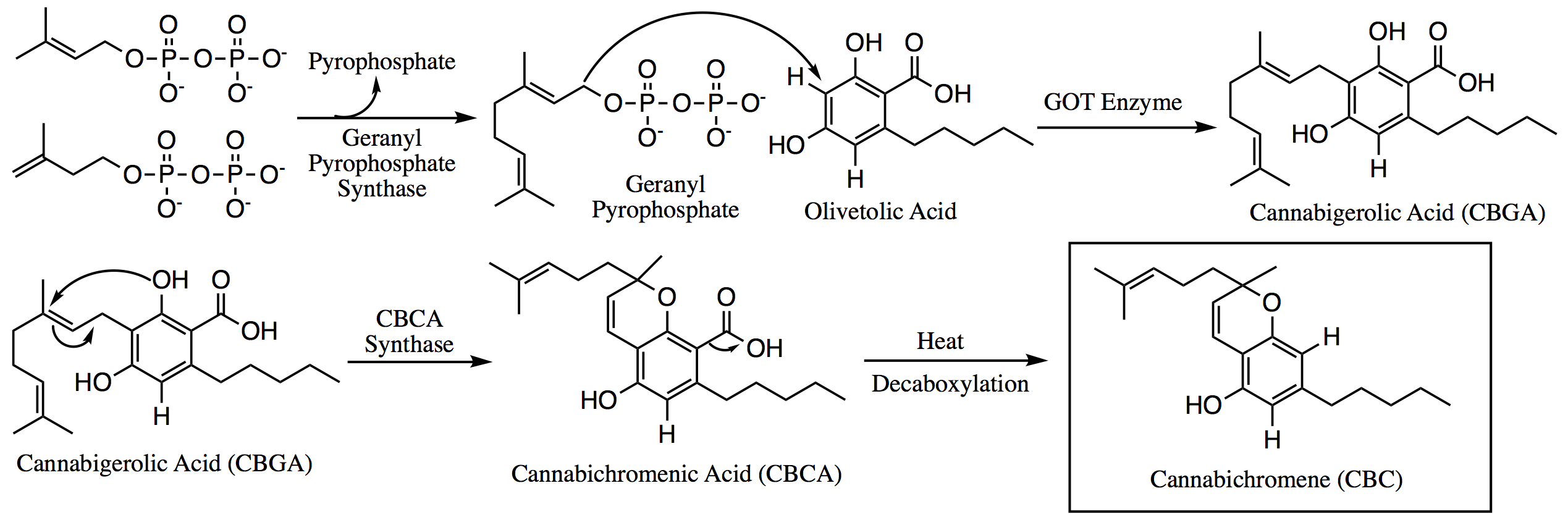Cannabichromene on:
[Wikipedia]
[Google]
[Amazon]
Cannabichromene (CBC), also called cannabichrome, cannanbichromene, pentylcannabichromene or cannabinochromene, exhibits

anti-inflammatory
Anti-inflammatory is the property of a substance or treatment that reduces inflammation, fever or swelling. Anti-inflammatory drugs, also called anti-inflammatories, make up about half of analgesics. These drugs reduce pain by inhibiting mechan ...
properties ''in vitro'', which may, theoretically, contribute to cannabis analgesic
An analgesic drug, also called simply an analgesic, antalgic, pain reliever, or painkiller, is any member of the group of drugs used for pain management. Analgesics are conceptually distinct from anesthetics, which temporarily reduce, and in s ...
effects.
It is a phytocannabinoid
Cannabinoids () are several structural classes of compounds found primarily in the ''Cannabis'' plant or as synthetic compounds. The most notable cannabinoid is the phytocannabinoid tetrahydrocannabinol (THC) (delta-9-THC), the primary psychoac ...
, one of the hundreds of cannabinoid
Cannabinoids () are several structural classes of compounds found primarily in the ''Cannabis'' plant or as synthetic compounds. The most notable cannabinoid is the phytocannabinoid tetrahydrocannabinol (THC) (delta-9-THC), the primary psychoact ...
s found in the ''Cannabis
''Cannabis'' () is a genus of flowering plants in the family Cannabaceae that is widely accepted as being indigenous to and originating from the continent of Asia. However, the number of species is disputed, with as many as three species be ...
'' plant. It bears structural similarity to the other natural cannabinoids, including tetrahydrocannabinol
Tetrahydrocannabinol (THC) is a cannabinoid found in cannabis. It is the principal psychoactive constituent of ''Cannabis'' and one of at least 113 total cannabinoids identified on the plant. Although the chemical formula for THC (C21H30O2) de ...
(THC), tetrahydrocannabivarin
Tetrahydrocannabivarin (THCV, THV, O-4394, GWP42004) is a Homologous series, homologue of tetrahydrocannabinol (THC) having a propyl (3-carbon) side chain instead of pentyl (5-carbon), making it non-psychoactive in lower doses. It has been shown ...
(THCV), cannabidiol
Cannabidiol (CBD) is a phytocannabinoid, one of 113 identified cannabinoids in ''Cannabis'', along with tetrahydrocannabinol (THC), and accounts for up to 40% of the plant's extract. Medically, it is an anticonvulsant used to treat multiple f ...
(CBD), and cannabinol (CBN), among others. It is not scheduled by the Convention on Psychotropic Substances
The Convention on Psychotropic Substances of 1971 is a United Nations treaty designed to control psychoactive drugs such as amphetamine-type stimulants, barbiturates, benzodiazepines, and psychedelics signed in Vienna, Austria on 21 February ...
.
Biosynthesis
Within the ''Cannabis
''Cannabis'' () is a genus of flowering plants in the family Cannabaceae that is widely accepted as being indigenous to and originating from the continent of Asia. However, the number of species is disputed, with as many as three species be ...
'' plant, CBC occurs mainly as cannabichromenic acid (CBCA, 2-COOH-CBC, CBC-COOH). Geranyl pyrophosphate and olivetolic acid combine to produce cannabigerolic acid (CBGA; the sole intermediate for all other phytocannabinoids), which is cyclized by the enzyme CBCA synthase to form CBCA. Over time, or when heated above 93 °C, CBCA is decarboxylated, producing CBC. See also the biosynthetic scheme image below.
:
Pharmacology
Cannabichromene has been hypothesized to affect THC psychoactivity, though ''in vivo'' effects have not been demonstrated. CBC acts on theTRPV1
The transient receptor potential cation channel subfamily V member 1 (TRPV1), also known as the capsaicin receptor and the vanilloid receptor 1, is a protein that, in humans, is encoded by the ''TRPV1'' gene. It was the first isolated member of ...
and TRPA1 receptors, interfering with their ability to break down endocannabinoids (chemicals such as anandamide and 2-AG that the body creates naturally). CBC has shown antitumor effects in breast cancer xenoplants in mice. It also has anticonvulsant
Anticonvulsants (also known as antiepileptic drugs, antiseizure drugs, or anti-seizure medications (ASM)) are a diverse group of pharmacological agents used in the treatment of epileptic seizures. Anticonvulsants are also used in the treatme ...
activity in a mouse model.
''In vitro
''In vitro'' (meaning ''in glass'', or ''in the glass'') Research, studies are performed with Cell (biology), cells or biological molecules outside their normal biological context. Colloquially called "test-tube experiments", these studies in ...
'', CBC binds weakly to CB1 and CB2 with binding affinities of 713 nM and 256 nM, respectively, which are significantly lower than that for THC with 35 nM at CB1. acting as an agonist for cAMP stimulation and an antagonist at beta-arrestin. Additionally, CBC is an agonist of TRPA1, and less potently TRPV3 and TRPV4
Transient receptor potential cation channel subfamily V member 4 is an ion channel protein that in humans is encoded by the ''TRPV4'' gene.
The ''TRPV4'' gene encodes TRPV4, initially named "vanilloid-receptor related osmotically activated chann ...
. CBC has two stereoisomers.
References
{{Transient receptor potential channel modulators Anti-inflammatory agents Phytocannabinoids Benzopyrans Hydroxyarenes Transient receptor potential channel modulators